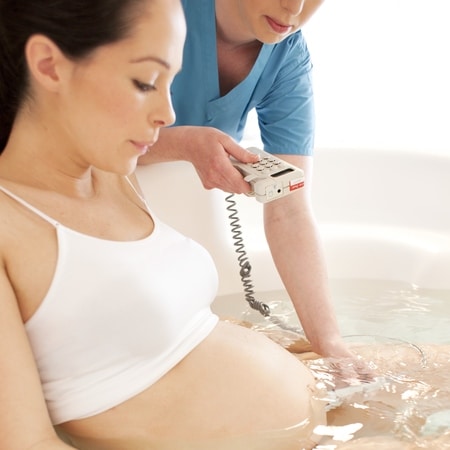Waterbirths have been a delivery choice of moms for decades, with their popularity increasing in recent years. Reduced pain, natural buoyancy, and decreased chances of tearing are just a few of the reasons why moms pick this natural, calm setting to welcome their babies.
But, like with all birthing methods, there can be risks to mom and baby when delivering in the water. Today the American College of Obstetricians and Gynecologists(ACOG) and the American Academy of Pediatrics (AAP), in a joint Committee Opinion today released new recommendations noting that undergoing the early stages of labor in a birthing pool may offer some advantages to pregnant women. However, underwater delivery has no proven benefit to women or babies and may even pose a risk of serious health problems for the newborn.
“Many labor and delivery units are equipped with tubs to be used by laboring women, and immersion in water for relaxation and pain relief is appealing to some,” said Jeffrey L. Ecker, MD, chair of the College’s Committee on Obstetric Practice said in a press release. “But it is important to recognize that laboring in water is not the same as delivering underwater. Laboring in water may offer some potential benefits, but delivering underwater does not seem to have clear advantages, and the risk of rare, but serious, consequences to a delivering baby’s health is something women and providers should all be aware of.”
“The members of the committees conducted a thorough review of the literature, and came to the conclusion that there is no evidence to support delivering babies in water has benefits to the baby,” says Tonse Raju, MD, chief, Pregnancy and Perinatology Branch, the National Institute of Child Health and Human Development (NICHD), who served as the NICHD liaison to the AAP Committee on Fetus and Newborn.
The new recommendation acknowledges that there may be some positive effects of water immersion to pregnant women during the early stages of labor, such as decreased pain or use of anesthesia and shorter labors. However, there is no evidence that giving birth underwater improves newborn outcomes.
To protect the health and safety of the baby during labor, the College and AAP lay out recommendations for hospitals or birth centers that plan to offer water immersion in the first stage of labor.
These include:
- Developing rigorous protocols for candidate selection;
- Maintaining and cleaning tubs and immersion pools;
- Following infection control procedures;
- Monitoring pregnant women at appropriate intervals while immersed; and
- Moving women out of the tubs if maternal or fetal concerns develop.
The Committee Opinion stresses that the safety and efficacy of immersion in water during the second stage of labor (underwater delivery) have not been established, nor has there been any benefit shown to women or newborns. Additionally, rare but serious health problems in the newborn have been reported. Potential risks of underwater delivery include a higher risk of maternal and neonatal infections; difficulty in the regulation of the baby’s body temperature; increased chance of umbilical cord damage; respiratory distress resulting from the baby inhaling tub water; and potential for seizures or asphyxiation of the baby following birth.







